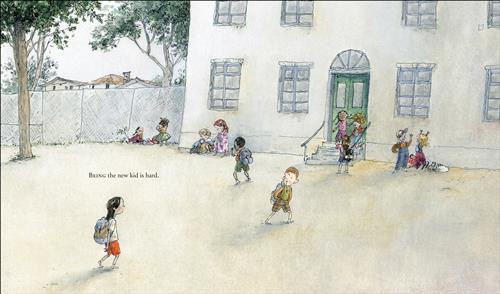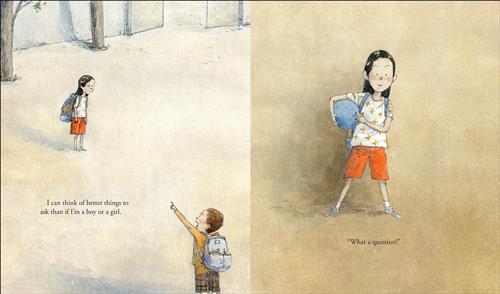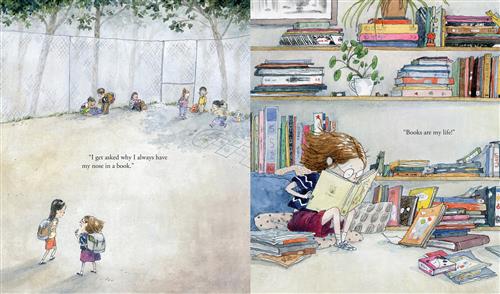In this companion to the enormously popular A Family Is a Family Is a Family, a group of kids share the silly questions they always hear, as well as the questions they would rather be asked about themselves.
Being the new kid is hard, a child in the school playground tells us. I can think of better things to ask than if I’m a boy or a girl. Another child comes along and says she gets asked why she always has her nose in a book. Someone else gets asked where they come from.
One after another, children share the questions they’re tired of being asked again and again — as opposed to what they believe are the most important or interesting things about themselves. As they move around the playground, picking up new friends along the way, there is a feeling of understanding and acceptance among them. And in the end, the new kid comes up with the question they would definitely all like to hear: “Hey kid, want to play?”
Sara O’Leary’s thoughtful text and Qin Leng’s expressive illustrations tell a story about children who are all different, all themselves, all just kids.
Key Text Features
dialogue
Correlates to the Common Core State Standards in English Language Arts:
CCSS.ELA-LITERACY.RL.1.6
Identify who is telling the story at various points in a text.
CCSS.ELA-LITERACY.RL.1.7
Use illustrations and details in a story to describe its characters, setting, or events.
CCSS.ELA-LITERACY.RL.2.1
Ask and answer such questions as who, what, where, when, why, and how to demonstrate understanding of key details in a text.
CCSS.ELA-LITERACY.RL.2.6
Acknowledge differences in the points of view of characters, including by speaking in a different voice for each character when reading dialogue aloud.
CCSS.ELA-LITERACY.RL.2.7
Use information gained from the illustrations and words in a print or digital text to demonstrate understanding of its characters, setting, or plot.
CCSS.ELA-LITERACY.RL.3.1
Ask and answer questions to demonstrate understanding of a text, referring explicitly to the text as the basis for the answers.
CCSS.ELA-LITERACY.RL.3.7
Explain how specific aspects of a text's illustrations contribute to what is conveyed by the words in a story (e.g., create mood, emphasize aspects of a character or setting)
In this companion to the enormously popular A Family Is a Family Is a Family, a group of kids share the silly questions they always hear, as well as the questions they would rather be asked about themselves.
Being the new kid is hard, a child in the school playground tells us. I can think of better things to ask than if I’m a boy or a girl. Another child comes along and says she gets asked why she always has her nose in a book. Someone else gets asked where they come from.
One after another, children share the questions they’re tired of being asked again and again — as opposed to what they believe are the most important or interesting things about themselves. As they move around the playground, picking up new friends along the way, there is a feeling of understanding and acceptance among them. And in the end, the new kid comes up with the question they would definitely all like to hear: “Hey kid, want to play?”
Sara O’Leary’s thoughtful text and Qin Leng’s expressive illustrations tell a story about children who are all different, all themselves, all just kids.
Key Text Features
dialogue
Correlates to the Common Core State Standards in English Language Arts:
CCSS.ELA-LITERACY.RL.1.6
Identify who is telling the story at various points in a text.
CCSS.ELA-LITERACY.RL.1.7
Use illustrations and details in a story to describe its characters, setting, or events.
CCSS.ELA-LITERACY.RL.2.1
Ask and answer such questions as who, what, where, when, why, and how to demonstrate understanding of key details in a text.
CCSS.ELA-LITERACY.RL.2.6
Acknowledge differences in the points of view of characters, including by speaking in a different voice for each character when reading dialogue aloud.
CCSS.ELA-LITERACY.RL.2.7
Use information gained from the illustrations and words in a print or digital text to demonstrate understanding of its characters, setting, or plot.
CCSS.ELA-LITERACY.RL.3.1
Ask and answer questions to demonstrate understanding of a text, referring explicitly to the text as the basis for the answers.
CCSS.ELA-LITERACY.RL.3.7
Explain how specific aspects of a text's illustrations contribute to what is conveyed by the words in a story (e.g., create mood, emphasize aspects of a character or setting)
| Published By | Groundwood Books Ltd — Aug 1, 2021 |
| Specifications | 32 pages | 8.5 in x 10 in |
| Keywords | determining importance; Common Core aligned; CC Literature Key Ideas and Details; CC Literature Craft and Structure; CC Literature Integration of Knowledge and Ideas; grade 1; grade 2; grade 3; picture book; dialogue; |
|
Supporting Resources
(select item to download) |
Teacher's Guide |
| Written By |
SARA O'LEARY, an author of books for children and adults, has won the Vicky Metcalf Award for Literature for Young People. Her notable picture books include A Family Is a Family Is a Family (USBBY Outstanding International Books) and A Kid Is a Kid Is a Kid (TD Canadian Children’s Literature Award finalist), both illustrated by Qin Leng, and The Little Book of the Little Brontës, illustrated by Briony May Smith, praised by SLJ for its “exquisitely crafted text.” Sara lives in Lunenburg County, Nova Scotia. |
| Illustrated by |
QIN LENG is a highly acclaimed illustrator and author of picture books and graphic novels. Her work appears in the award-winning Who We Are series by Sara O’Leary; Trèfle by Nadine Robert (Governor General Award); Hana Hashimoto, Sixth Violin by Chieri Uegaki (APALA Award, Governor General’s Award finalist); and When I Found Grandma by Saumiya Balasubramaniam (Marilyn Baillie Picture Book Award finalist); among others. Qin has written and illustrated I Am Small and Fantastic Lou: Little Comics from Real Life. She lives in Toronto, Ontario. |
| Written By |
|
SARA O'LEARY, an author of books for children and adults, has won the Vicky Metcalf Award for Literature for Young People. Her notable picture books include A Family Is a Family Is a Family (USBBY Outstanding International Books) and A Kid Is a Kid Is a Kid (TD Canadian Children’s Literature Award finalist), both illustrated by Qin Leng, and The Little Book of the Little Brontës, illustrated by Briony May Smith, praised by SLJ for its “exquisitely crafted text.” Sara lives in Lunenburg County, Nova Scotia. |
| Illustrated by |
|
QIN LENG is a highly acclaimed illustrator and author of picture books and graphic novels. Her work appears in the award-winning Who We Are series by Sara O’Leary; Trèfle by Nadine Robert (Governor General Award); Hana Hashimoto, Sixth Violin by Chieri Uegaki (APALA Award, Governor General’s Award finalist); and When I Found Grandma by Saumiya Balasubramaniam (Marilyn Baillie Picture Book Award finalist); among others. Qin has written and illustrated I Am Small and Fantastic Lou: Little Comics from Real Life. She lives in Toronto, Ontario. |
| Audience | ages 3 to 6 / grades P to 1 |
| Reading Levels |
Guided Reading L
Fountas & Pinnel Text Level L |
| Key Text Features | dialogue |
| Common Core |
CCSS.ELA-LITERACY.RL.3.7
CCSS.ELA-LITERACY.RL.2.1 CCSS.ELA-LITERACY.RL.3.1 CCSS.ELA-LITERACY.RL.1.7 CCSS.ELA-LITERACY.RL.1.6 CCSS.ELA-LITERACY.RL.2.6 CCSS.ELA-LITERACY.RL.2.7 |
Short-listed, TD Canadian Children's Literature Award, 2022
Short-listed, Ruth and Sylvia Schwartz Children's Book Award, 2022
Winner, Ontario Library Association Best Bets, 2021
Commended, Canadian Children’s Book Centre, Best Books for Kids and Teens, 2022
Short-listed, TD Canadian Children's Literature Award, 2022
“[N]ot only a fantastic companion to its highly acclaimed predecessor but also a stand-alone book that reminds us kids have more to share, if only we asked better questions.” — Quill & Quire, STARRED REVIEW
“[A] celebration of diversity and inclusion … The joyful pictures and intriguing questions will certainly inspire spirited discussion.” — Booklist
“With a unanimous spirit of inclusion within its pages, the story urges readers to rethink the way they first encounter others."” — Horn Book
“A wonderful book about diversity, acceptance, and friendship.” — Calgary Herald
“An excellent story with a theme that all kids can relate to.” — CM: Canadian Review of Materials
“A lovely book that focuses on thinking critically about the questions we ask each other.” — Toronto Star
“A marvellous follow-up to A Family Is a Family Is a Family.” — Canadian Children's Book News




